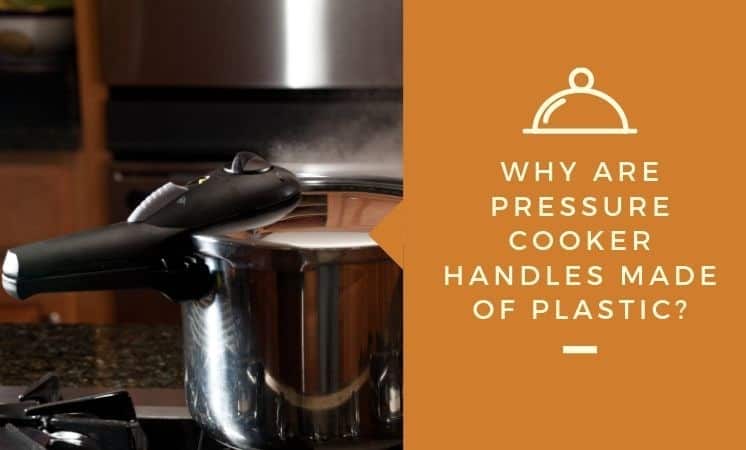So you’ve noticed it too. The main unit and the lid are made of either stainless steel or other metal but the actual handles are made of plastic. Well, as it turns out, there’s actually a reason behind the choice of material for the pressure cooker’s handles.
Out of pure curiosity, I did some research on the topic and figured I would make a post about it to enlighten others with my findings.
So, why are a pressure cooker’s handles made of plastic rather than metal? A pressure cooker’s handles are made of a type of plastic called Bakelite, which is a material with heat resistant properties. Bakelite doesn’t conduct heat very well and is also an electric insulator. Metal, on the other hand, conducts heat very well and is, therefore, a bad choice for the handles.
This way, the user can actually move the pressure cooker once it has finished cooking without burning his or her fingers. That would not be the case if the handles were made of metal. Bakelite, the thermosetting plastic, doesn’t weigh much either – which helps keep the total weight of the unit down. Pressure cookers are quite heavy even without the metal handles.
Using plastic is both cheaper and easier to handle than metal. But not all handles are made of Bakelite, some are actually made of a composite of nylon and glass fiber. The composite is also, like Bakelite, resistant to heat and will keep the handles cool even when the unit is hot.
Inside the plastic handles, there’s most likely a metal part that’s bolted to the main unit to reinforce the cooker’s handles.
But regular pans and pots come with metal handles, why is that?
Regular pans and pots are often placed in the oven, the same is not true for pressure cookers as they have their own internal heating source (if it’s an electric pressure cooker). In the oven, the plastic handles would not be able to handle the temperature and, eventually, melt.
Third generation pressure cookers are electric and should definitely not be placed in the oven as they will malfunction and potentially start a fire. However, electric pressure cookers come with steel inserts that can be removed from the main unit. These could, potentially, be placed in the oven but I don’t see why you would want to.
But even traditional stovetop pressure cookers are better kept on the stove as the user must monitor pressure levels and make manual adjustments when needed.
That’s why they come with plastic handles. The plastic doesn’t conduct heat so the user doesn’t get burned – which would happen if they were made of metal as the inside temperature of the pressure cooker goes up to 122 degrees Celsius. When it comes to placing the pressure cooker in the oven, I don’t recommend it.
How Is Bakelite Made?
The thick plastic covering a pressure cooker’s handles is called Bakelite or polyoxybenzylmethylenglycolanhydride. For the sake of the reader, I will refer to it as Bakelite in this article.
Bakelite was first developed by Leo Baekeland in New York, back in 1907. The first plastic of its kind, crafted from synthetic components, Bakelite came to be known for its heat-resistant and electric insulation properties.
In the past, Bakelite was used to make a lot of things:
- Telephone casings
- Knobs
- Kitchenware
- Jewelry
- Toys
But over the years, new plastic was discovered and the use of Bakelite started to fade.

Bakelite is made from reacting phenol and formaldehyde. The composite can be heated and softened in its first stages but the final structure does not react to heat and cant be softened by it.
- Stage A: Solid but still soluble in a solvent
- Stage B: Hard and no longer soluble, but still softened by heat.
- Stage C: Insoluble and not softened by heat.
By heating stage A+B, Baekeland was able to produce C. While insoluble and resistant to heat, the product was still puffy and brittle. To counteract the part of the process that puffed up the Bakelite, he invented the Bakelizer.
The Bakelizer heated the product to 150 degrees Celsius/300 degrees Fahrenheit under pressure, this suppressed the foaming and the first non-puffy Bakelite was created.
Replacing a Pressure Cooker’s Handles
You can find a bunch of replacement parts on Amazon and other online stores. I do recommend that you get in contact with the company that manufactured your pressure cooker prior to purchasing a handle online.
In case your handles have been damaged or rendered useless, perhaps they can provide replacement parts or even better, an entirely new unit.
Pressure Cookers Are Much Safer Now
Everyone has heard of a pressure cooker exploding, splashing hot liquids and food all over the kitchen and causing severe burns. Well, if that happened as often as some may believe, the use of pressure cookers would be restricted to experienced professionals only.
Modern pressure cookers, especially electric ones, are geared with many safety features which automate the process of monitoring pressure and temperature.
Take the Instant Pot for example.
The Instant Pot has several sensors that power the heating element periodically when pressure levels are decreasing, this way, the heat source is only used when needed, and if the Instant Pot happens to sense unsafe conditions, it shuts off automatically to keep the user safe.
I’ve written an article that outlines the differences between electric pressure cookers and regular stovetop pressure cookers.
Conclusion
Now you understand why a pressure cooker’s handles are made of plastic, and not just any plastic. If it wasn’t for the plastic, we would have to wear mittens to carry our cookers. Because plastic is relatively cheap to produce, it also keeps down the production costs a little bit.
The next time you carry your cooker by the handle why the unit is hot, remember that the Bakelite in the handle is responsible.

